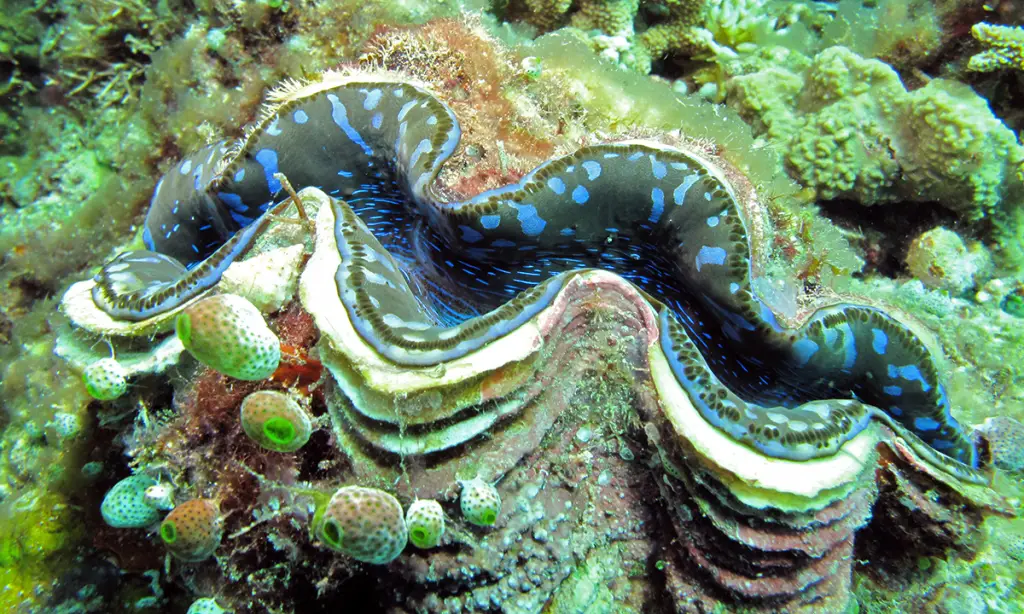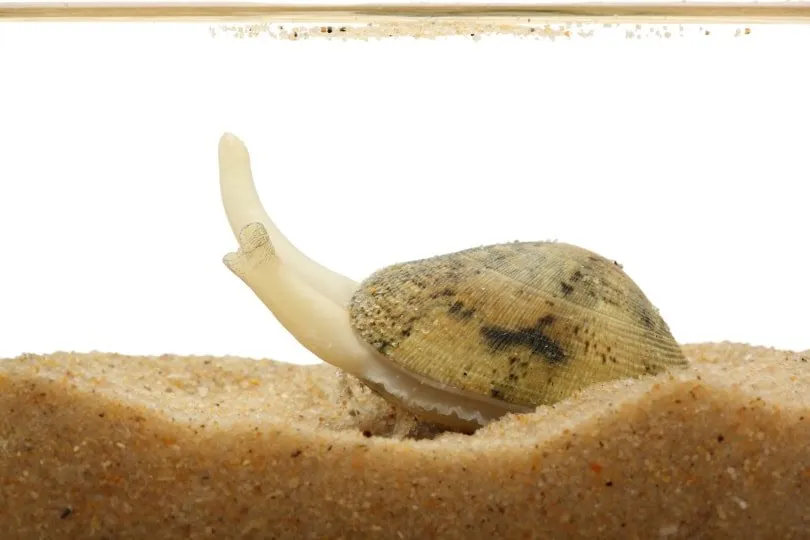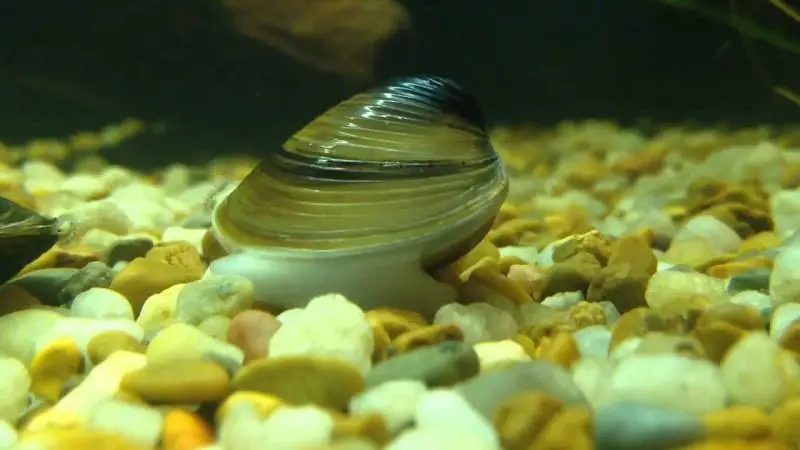As an Amazon Associate I earn from qualifying purchases.
If you’re curious about what clams eat, you’ve come to the right place! In this blog post, we will explore the different diets of clams in both saltwater and freshwater habitats. Clams are interesting creatures with a variety of feeding habits. Some clams are scavengers, while others are predators. Let’s take a closer look at what these bivalves eat!
What do clams eat?
Clams are filter feeders, which means that they strain small food particles from the water around them. Phytoplankton, zooplankton, and other tiny organisms make up the majority of a clam’s diet. Clams use their gills to capture these microscopic creatures and pump water through their bodies to extract the nutrients they need. Clams can filter a lot of water in a day – up to 20 gallons per hour!
What do clams eat in the ocean?
In saltwater habitats, clams mostly eat phytoplankton. Phytoplankton is microscopic plants that float in the ocean’s waters. These single-celled organisms provide energy for many marine creatures, including clams. Clams also eat zooplankton, which are tiny animals that live in the ocean. Zooplankton includes creatures like crustaceans, mollusks, and small fish. What do clams eat in freshwater?
In freshwater habitats, clams primarily eat algae and other plant matter. Algae are single-celled organisms that live in water. Some types of algae are green (like the kind you might see in a pond), while others are blue-green or red. Clams also consume diatoms, which are a type of algae with a hard shell made of silica. Diatoms can be found in both saltwater and freshwater habitats.
Do clams have predators?
Yes, clams have predators! One of the most common predators of clams is the crab. Crabs use their powerful claws to dig up clams from the sand and eat them. Another predator of clams is the octopus. Octopuses are skilled hunters that can pry open a clam’s shell and eat the soft tissue inside. Humans also harvest and consume clams, making us one of their main predators.

What do clams eat in freshwater?
In freshwater habitats, clams primarily eat algae and other plant matter. Algae are single-celled organisms that live in water. Some types of algae are green (like the kind you might see in a pond), while others are blue-green or red. Clams also consume diatoms, which are a type of algae with a hard shell made of silica. Diatoms can be found in both saltwater and freshwater habitats.
How do clams eat and breathe?
Clams are bivalves, which means that they have two shells that are hinged together. This arrangement protects their soft bodies from predators. Clams have a muscular foot that they use to burrow into the sand or mud. They also have gills that they use for filter-feeding and for respiration. When water passes over the clam’s gills, oxygen is absorbed and carbon dioxide is expelled.
Do clams have eyes?
No, clams do not have eyes. However, they do have light-sensitive cells on their mantle (the fleshy outer layer of their bodies) that help them detect changes in light intensity. This helps them know when it is safe to come out of their shells and feed.
What do clams eat besides plankton?
Clams are mostly filter-feeders, but they will also eat larger food items if they are available. Clams have been known to eat small shrimp, fish, and even other clams! If a clam is big enough, it may even capture and eat a crab.
What do giant clams eat?
Giant clams are the largest type of clam, and they can weigh up to 600 pounds! These massive bivalves are filter-feeders, and they mostly eat phytoplankton. Giant clams also consume zooplankton, small fish, and other small organisms.

How do scientists study what clams eat?
Scientists study what clams eat by collecting samples of water from different habitats and then analyzing them in a laboratory. They use microscopes to identify the types of plankton that are present in the water. This information helps scientists understand what clams (and other marine creatures) are eating in different parts of the ocean.
Do clams eat salt?
No, clams do not eat salt. In fact, they use their gills to filter out salt from the water that they are breathing. This is why it is important for clams to live in habitats with the right amount of salt. Too much or too little salt can be harmful to them.
Do clams eat brain?
No, clams do not have a brain. They have a simple nervous system that consists of a few nerve cells located in their mantle (the fleshy outer layer of their bodies). This nervous system helps them detect changes in their environment, but it does not give them the ability to think or feel pain.
What is the biggest clam in the world?
The giant clam is the largest type of clam, and it can weigh up to 600 pounds! These massive bivalves are filter-feeders, and they mostly eat phytoplankton. Giant clams also consume zooplankton, small fish, and other small organisms.

What is the smallest clam in the world?
The smallest clam in the world is the pea clam. These tiny clams only grow to be about 0.39 inches long! Pea clams are found in saltwater habitats all over the world. Like other clams, they are filter-feeders that primarily eat plankton.
Do clams move?
Yes, some types of clams can move slowly by using their muscular foot. However, most clams are stationary and remain in one place for their entire lives. This is because they are filter-feeders that rely on the water around them to bring them food.
What do baby clams eat?
Baby clams (called larvae) primarily eat plankton. Plankton are small, floating organisms that live in water. Some types of plankton are algae, while others are tiny animals. Baby clams use special filters to strain plankton out of the water. As they grow older, they will start to eat larger food items such as shrimp and small fish.
Do all clams have shells?
No, not all clams have shells. There are some types of clams that live in deep-sea habitats where the pressure is too high for them to form shells. These clams are called “shell-less” or “footless” clams. Even though they don’t have shells, they still have a hard outer layer that protects their bodies.

Do all clams eat plankton?
No, not all clams eat plankton. Some types of clams are carnivores and only eat other animals. However, most clams are filter-feeders and primarily eat plankton. Plankton is small, floating organisms that live in water. Some types of plankton are algae, while others are tiny animals. Baby clams use special filters to strain plankton out of the water. As they grow older, they will start to eat larger food items such as shrimp and small fish.
What is the lifespan of a clam?
The lifespan of a clam depends on the species. Some types of clams can live for over 100 years! However, most clams only live for a few years. The average lifespan of a clam is about 20 years.
What is the difference between a clam and a mussel?
The main difference between a clam and a mussel is that clams are scavengers and mussels are filter-feeders. This means that clams eat dead organisms, while mussels eat plankton. Both clams and mussels have two shells that are connected by a hinge. Clams are also generally larger than mussels.
What is the difference between a clam and an oyster?
The main difference between a clam and an oyster is that clams are scavengers and oysters are filter-feeders. This means that clams eat dead organisms, while oysters eat plankton. Both clams and oysters have two shells that are connected by a hinge. Clams are also generally larger than oysters.

How do clams reproduce?
Clams reproduce by releasing eggs and sperm into the water. The eggs and sperm will then fuse together to create a baby clam. Baby clams are called larvae, and they primarily eat plankton. Plankton are small, floating organisms that live in water. Some types of plankton are algae, while others are tiny animals. Baby clams use special filters to strain plankton out of the water. As they grow older, they will start to eat larger food items such as shrimp and small fish.
What is the purpose of a clam’s siphon?
A clam’s siphon is used for two main purposes: to breathe and to filter feed. The siphon is a tube-like structure that runs from the clam’s mouth to the outside of its shell. When the clam breathes, water enters its siphon and passes over its gills. The gills extract oxygen from the water and remove carbon dioxide. The filtered water then exits the siphon. When the clam filter feeds, water enters its siphon and passes over a special filter called a mantle. The mantle filters out plankton and other small organisms from the water.
What is a quahog?
A quahog is a type of hard-shelled clam that is native to North America. Quahogs are also known as “hard clams” or “round clams”. They are found in saltwater habitats along the Atlantic coast of the United States, from Maine to Florida. Quahogs are a popular type of seafood, and they are often used in chowder or fried clam dishes.
What is a geoduck?
A geoduck is a type of giant clam that is native to the coasts of North America and Asia. Geoducks are the largest type of clam in the world, and they can weigh up to 15 pounds! They are found in saltwater habitats along the Pacific coast of North America, from Alaska to California. Geoducks are a popular type of seafood, and they are often used in Asian cuisine.

What is a razor clam?
A razor clam is a type of long-necked clam that is native to the coasts of Europe and North America. Razor clams get their name from their long, razor-sharp shells. They are found in saltwater habitats along the Atlantic and Pacific coasts of North America, as well as the coast of Europe. Razor clams are a popular type of seafood, and they are often used in clam dishes such as chowder or fritters.
What is a giant clam?
A giant clam is a type of large clam that is native to the coasts of Asia and Australia. Giant clams can weigh up to 660 pounds! They are found in saltwater habitats along the coastlines of Asia and Australia. Giant clams are a popular type of seafood, and they are often used in Asian cuisine.
Conclusion
Clams are a type of shellfish that can be found in saltwater habitats all over the world. There are many different types of clams, and they come in a variety of sizes. Clams are a popular type of seafood, and they are often used in dishes such as chowder or fried clams.
You may also read:
- What Do Tuna Eat? The Diet of a Marine Predator
- What Do Angelfish Eat? 10 Delicious Options for Your Aquarium
- What Do Phytoplankton Eat? A Guide to the Diet of These Tiny Sea Creatures
Amazon and the Amazon logo are trademarks of Amazon.com, Inc, or its affiliates.

